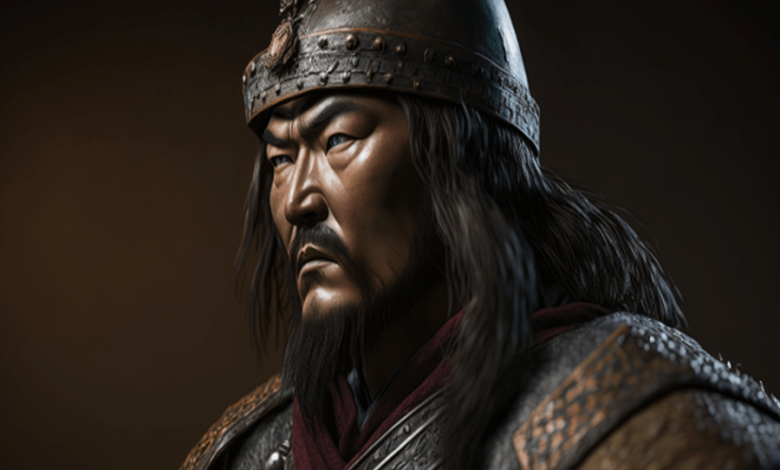Genghis Khan: Biography and Story of the Mongolian Conqueror

Genghis Khan is known to the world as the greatest conqueror the world has ever seen. He was the ruler or emperor of the Mongolian kingdom. When he came to power, Genghis Khan’s territory covered almost the entire continent of Asia to parts of mainland Europe such as Russia.
His conquest of territory was carried out by means of genocide or eliminating people or nations in that region. During his time in power he was responsible for the massacre of 40 million people during his conquest. When he died, his territory had reached 13.5 million kilometers.
Quick Info
| Full Name | Temujin ( Genghis Khan ) |
| Date of Birth | Delüün Boldog, Mongolia, 1162 |
| Died | Yinchuan, China, August 18, 1227 |
| Parents | Father – Yesügei
Mother – Ho’elun |
| Wife | Börte, Khulan khatun, Yesui, Yesugen, Heda’an, Gurbasu Khatun |
| Child | Ogadai Khan, Jochi Khan, Tolui, Chagatai Khan, Alakhai Bekhi, Checheikhen, Gelejian, Tümelün, Alaltun, Altani, Khochen Beki. |
| Known As | Emperor of Mongolia, the Conqueror |
Genghis Khan Biography
Genghis Khan was born around 1162. His father was a small tribal chief. He named his son Temujin after he defeated another tribal chief.
When Temujin was nine years old, his father was killed by a rival tribe, and after that the surviving members of his family were in the grip of fear and isolation.
Early Life
This was truly the beginning of a bitter life, and for Temujin even more so before there were changes for the better for him. When he was a young teenager, he was captured in a battle against his rival tribe.
To prevent him from escaping, a bamboo bracelet was hung around his neck. From a situation where there is no visible way to escape in the custody of a group of primitive illiterates. From a dry land, Temujin, who later became known as Genghis Khan, was able to rise to become the strongest man in the world.
His rise began with his efforts to escape from his opponent’s custody. Then he joined forces with Toghril, a close friend of his late father, a tribal chief with ties to the area.
The following years were full of clashes between tribes, Temujin, step by step, struggled to reach the top.
The Mongol tribes were long known as skilled horsemen and fierce, merciless warriors. Throughout history they have relentlessly attacked northern China.
However, before Temujin appeared, Mongolian tribes liked to fight each other to waste their energy. By skillfully combining courage, diplomacy, violence and organizational skills, Temujin succeeded in uniting all the tribes under his leadership. Stay up-to-date with Deltsapure! Provide accurate and updated news for readers.
Genghis Khan’s title
In the biography of Genghis Khan, it is stated that in 1206 a large deliberation between the Mongol tribes gave Temujin the nickname “Genghis Khan” which means “Emperor of the universe.”
Military Expansion into China
Genghis Khan’s terrifying military power that he raised aimed his spearhead at adjoining countries. First he attacked the Hsi Hsia in northeastern China and the Chin Empire in northern China.
When the battle took place, a dispute arose between him and Khwarezm Shah Muhammad, who ruled a fairly large empire in Persia and Central Asia.
In 1219, the ruler of the Mongolian empire marched his troops against Khwarezm Shah. Central Asia and the Persian Empire were taken over and Shah Muhammad’s Khwarezm empire was destroyed. According to historians, Genghis Khan was responsible for the decline in China’s population during his conquest.
Genghis Khan Dies
At the same time that part of the Mongol troops attacked Russia, Genghis Khan personally led the army to invade Afghanistan and northern India. He returned to Mongolia in 1225 and died there in 1227.
Where is Genghis Khan’s Tomb?
No one knows where Genghis Khan’s grave is. It is said that according to the story, Genghis Khan was buried in an unmarked grave. There are no historical records that state where Genghis Khan’s grave is located.
In fact, according to legend, the soldiers and workers who took part in burying the Mongolian emperor were killed so that the secret of his tomb could be kept tightly closed.
The Mongol Empire After Genghis Khan
In the biography of Genghis Khan, it is known that shortly before he breathed his last breath, he asked that his third son, Ogadai, be appointed as his successor. This was a wise choice because Ogadai became a brilliant general due to his own efforts.
Under his leadership, the Mongol army continued its invasion of China, completely conquered Russia, and advanced towards Europe.
In 1241 the combined Polish, German and Hungarian armies were completely defeated by the Mongols who were advancing rapidly towards Budapest. However, that year Ogadai died and the Mongol troops withdrew from Europe and never returned.
In 1279 the Mongols had controlled the largest empire in history. His regional control included China, Russia, Central Asia, as well as Persia and Southeast Asia.
His armies made successful advances expanding areas stretching from Poland to northern India, and Kublai Khan’s rule ended in Korea, Tibet, and parts of Southeast Asia.
Next
An empire of such vast area was naturally difficult to overcome through a primitive transportation system. The result was that it was impossible to maintain the integrity of the territory, so that in the end the empirium was divided.
However, Mongol rule was still able to last for years. The Mongols were only driven from most of China in 1368. In fact, their rule over the Russian region lasted much longer.
Genghis Khan’s other great-grandchildren founded dynasties that ruled Central Asia and Persia. These two areas were conquered in the 14th century by Tamerlane (Tamerlane), who was also of Mongol blood and claimed to be a descendant of Gengtis. Tamerlane’s dynasty ended in the 15th century.
But even though this ended, it did not mean that the Mongol conquests and control had stopped. Tamerlane’s great-grandson named Baber invaded and occupied India and founded the Mogul (Mongol) dynasty. The Mogul rulers, who controlled almost all of India, remained in power until the mid-18th century.
In Genghis Khan’s biography, one indirect result of Genghis Khan’s conquest has its own meaning. The Mongol conquest that coincided with the unification of much of Asia further developed trade routes in the region than previously possible.
And at the same time encouraging trade flows between China and Europe. European traders such as Marco Polo were thus able to travel to China and return with all kinds of stories about how rich and prosperous China was.




